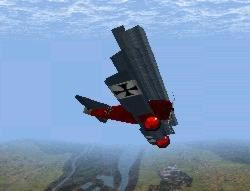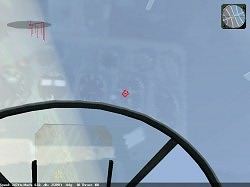|
To Padlock or Not to Padlock
By Biff Henderson |
||||
|
Solving the Problems For the sake of brevity, let's say that numbers 3 through 7 are straightforward fixes. The only ones that I see possible difficulty with are 4 and 7, the high g and greyout problems. At high g, a pilot's head should move slower, and should probably also have a more restricted degree of movement. The debate here would be on exactly how slow, and how restricted. The difficulty with the greyout point is very similar to the first and second items on the above list, so let's lump them all together.
 Fig. . Rowan's Flying Corps: Player to Target Lock Should padlock be lost when the target moves out of direct line of sight? I believe the answer is.. yes and no. Let's use the automobile scenario again. When you are 'locked on' to that interesting item on the side of the road, when it passes behind your window post for a quarter of a second, do you automatically snap your head back forward because you can't see it anymore? No, you are pretty confident that it will reappear soon, and you also have a darn good idea as to exactly where it will reappear. Now let's say you're driving one of those new urban assault vehicles that sit 10 feet above the road, and while stopped at an intersection a little Miata is crossing in front of you. As it crosses from left to right, it will disappear beneath that huge snout of yours for a second or two before reappearing on the other side… unless he makes the left turn while in your blind spot.
 MiG Alley Ok, so now it appears that the decision of losing padlock should depend on the amount of time that the target is out of sight. When an aircraft flashes under the leading edge of my wing, I'm 99.99% confident that it will reappear from under the trailing edge a tenth of a second later. Breaking padlock in this case makes no sense. Let's say for the sake of argument that it takes a long time for him to reappear. Perhaps he's parked near the end of the runway and I'm just taking off. I'm still 99.99% sure of where and when he'll reappear, even though he will now be obscured by my wing for 1 or 2 seconds instead of a tenth of a second. Hmm… so maybe breaking padlock based on the amount of time that a target is not in direct line of sight isn't the answer. An Elegant Solution? I believe that I have a better solution. The padlock view should have a bit of intelligence programmed in, as well as a couple of modes. The intelligence part has to do with the making of an assumption as to where a target will reappear after it leaves direct line of sight. For example, when the target is moving from right to left and disappears under the right side of our nose, we can assume that it will reappear in a corresponding position on the left side. Our virtual pilot should be able to make this same simple assumption on his own, and move his eyes accordingly. This is probably the trickiest part to code, but I think it's certainly doable. |
 Falcon 4.0 Now on to the really cool part, padlock modes. The padlock view should have passive and active modes. Active mode is when the target is in direct line of sight - the view pans with the target, keeping it near the center of the view. When the target leaves direct line of sight, padlock goes into a passive mode - panning to the most likely position that the target will reappear and waiting for it to do so. When it does reappear, the view locks on again and switches back to active mode. I believe that this would be a faithful reproduction of how a real pilot's eyes and brain work, while not allowing the impossible: staying locked on a target that switches flight paths and doesn't reappear where we think it will. The beauty of this is that if the target doesn't reappear exactly where your virtual pilot thinks it will, as long as it reappears anywhere within that field of view he'll pick it up and lock back on to it, much like a real pilot would. If it doesn't reappear, then you'll have to make the decision as to how long you want to keep staring at that sector in space, waiting, before going back to snap views and looking for it elsewhere. This same sort of logic applies to grayouts also. Even though you lose sight, in your head you have a pretty good idea of where the target is, and as soon as your sight comes back you would be looking there. Blackouts and g-loc's are entirely different of course. This seems a relatively simple and elegant solution for all the problems that current padlock implementations suffer. I welcome all comments, suggestions, and debates on this topic. And for game developers, I'll send you the address to mail the checks to. Response: Andy Bush, USAF (ret.) I'll add one piece to this discussion. In real life, the head position is set prior to the addition of G. Most pilots don't want to risk the good chance of strained neck muscles, so they avoid head movements at high G. That means that to keep the target in sight under these conditions, they have to move the airplane, not their head. How would this be implemented in a sim? Perhaps, as Biff suggests, a graying and slowing of head movement as the G load increases. Then, perhaps at some relatively high value (>6 G?), the head is presumed to be 'fixed' and no more padlock movement is allowed. If the target then flys out of sight behind some part of the aircraft, the padlock stays at its present position until the pilot (1) relaxes G, or (2) rolls or pulls to a new aircraft position that will bring the target back into the padlock area of view. This is how it would be in real life. Your discussion of the padlock behavior when the target flys behind a part of the aircraft is particularly good. It does replicate the 'no tally' logic that a real world pilot would use to regain sight. Good luck on attracting the attention of developers. I've always hoped my involvement in sims would progress from writing to development, but to date no one has been beating down my door! Join a discussion forum on this article by clicking HERE.
|
|||
|
Copyright © 1997, 1998, 1999, 2000 COMBATSIM.COM, INC. All Rights Reserved. Last Updated January 28th, 1999 |
||||
